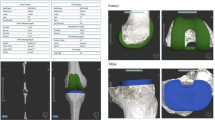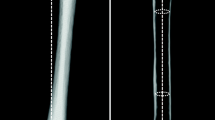Abstract
Purpose
To present a clinical validation of a novel technology called “3X” which allows for 3D prosthesis planning and treatment evaluation in total knee arthroplasty (TKA) using only 2D X-ray radiographs.
Materials and methods
After local institution review board approvals, 3X was evaluated on 43 cases (23 for preoperative planning and 20 for postoperative treatment evaluation). All the patients underwent CT scans according to a standard protocol. The results measured on the CT data were regarded as the ground truth. Additionally, two X-ray images were acquired for each affected leg and were used by 3X technology to derive patient-specific measurements of the leg. In total, we compared seven parameters for planning TKA and five parameters for postoperative prosthesis alignment.
Results
Our experimental results demonstrated that the mean distances between the surface models reconstructed from 2D X-rays and the associated surface models obtained from 3D CT data were smaller than 1.5 mm. The average differences for all angular parameters were smaller than \(1.5^{\circ }\). In over 78% cases 3X technology derived the same femoral component size as the CT-based ground truth and this value went down to 70% when 3X technology was used to predict the size of tibial component.
Conclusion
3X is a technology that allows for true 3D preoperative planning and postoperative treatment evaluation based on 2D X-ray radiographs.





Similar content being viewed by others
References
Baka N, Kaptein B, de Bruijne M, van Walsum T, Giphart J, Niessen W, Lelieveldt B (2011) 2D–3D shape reconstruction of the distal femur from stereo X-ray imaging using statistical shape models. Med Image Anal 15(6):840–850
Bäthis H, Perlick L, Tingart M, Lüring C, Zurakowski D, Grifka J (2004) Alignment in total knee arthroplasty: a comparison of computer-assisted surgery with the conventional technique. J Bone Joint Surg Br 86:682–687
Cerveri P, Sacco C, Olgiati G, Manzotti A, Baroni G (2017) 2D/3D reconstruction of the distal femur using statistical shape models addressing personalized surgical instruments in knee arthroplasty: a feasibility analysis. Int J Med Robot 13(4):e1823
Chaibi Y, Cresson T, Aubert B, Hausselle J, Neyret P, Hauger O, de Guise J, Skalli W (2012) Fast 3D reconstruction of the lower limb using a parametric model and statistical inferences and clinical measurements calculation from biplanar X-rays. Comput Methods Biomech Biomed Eng 15(5):457–466
Chen C, Xie W, Franke J, Grutzner P, Nolte L, Zheng G (2014) Automatic X-ray landmark detection and shape segmentation via data-driven joint estimation of image displacements. Med Image Anal 18:487–499
Cheriet F, Laporte C, Kadoury S, Labelle H, Dansereau J (2007) A novel system for the 3-D reconstruction of the human spine and rib cage from biplanar X-ray images. IEEE Trans Biomed Eng 54(7):1356–1358
De Valk E, Noorduyn J, Mutsaerts E (2016) How to assess femoral and tibial component rotation after total knee arthroplasty with computed tomography: a systematic review. Knee Surg Sports Traumatol Arthrosc 24:3517–3528
Ettinger M, Claassen L, Paes P, Calliess T (2016) 2D versus 3D templating in total knee arthroplasty. Knee 23:149–151
Henckel J, Richards R, Lozhkin K, Harris S, Rodriguez y Baena F, Barrett A, Cobb J (2006) Very low-dose computed tomography for planning and outcome measurement in knee replacement. The imperial knee protocol. J Bone Joint Surg Br 88:1513–1518
Hirschmann M, Konala P, Amsler F, Iranpour F, Friederich N, Cobb J (2011) The position and orientation of total knee replacement components: a comparison of conventional radiographs, transverse 2D-CT slices and 3D-CT reconstruction. J Bone Joint Surg Br 93:629–633
Kim Y, Kim K-I, Choi JH, Lee K (2011) Novel methods for 3D postoperative analysis of total knee arthroplasty using 2D–3D image registration. Int Orthop 38:379–385
Kim Y, Park J, Kim J, Park S (2014) The relationship between the survival of total knee arthroplasty and postoperative coronal, sagittal and rotational alignment of knee prosthesis. Clin Biomech (Bristol, Avon) 26:384–391
Kobayashi A, Ishii Y, Takeda M, Noguchi H, Higuchi H, Toyabe S (2012) Comparison of analog 2D and digital 3D preoperative templating for predicting implant size in total knee arthroplasty. Comput Aided Surg 17:96–101
Kurtz SM, Ong KL, Lau E, Bozic KJ (2014) Impact of the economic downturn on total joint replacement demand in the United States. J Bone Joint Surg Am 96:624–630
Matziolis G, Krocker D, Weiss U, Tohtz S, Perka C (2007) A prospective, randomized study of computer-assisted and conventional total knee arthroplasty. Three-dimensional evaluation of implant alignment and rotation. J Bone Joint Surg Am 89:236–243
Meijer M, Boerboom A, Stevens M, Bulstra S, Reininga I (2014) Assessment of prosthesis alignment after revision total knee arthroplasty using EOS 2D and 3D imaging: a reliability study. PLoS One 9:e104613
Meijer M, Velleman T, Boerboom A, Bulstra S, Otten E, Stevens M, Reininga I (2016) The validity of a new low-dose stereoradiography system to perform 2D and 3D knee prosthetic alignment measurements. PLoS One 11:e0146187
Moura D, Barbosa J, Reis A, Tavares J (2010) A flexible approach for the calibration of biplanar radiography of the spine on conventional radiological systems. Comput Model Eng Sci 60(2):115–138
Moura D, Boisvert J, Barbosa J, Labelle H, Tavares J (2011) Fast 3D reconstruction of the spine from biplanar radiogaphs using a deformable articulated model. Med Eng Phys 33:924–933
Okamoto S, Mizu-uchi H, Okazaki K, Hamai S, Tashiro Y, Nakahara H, Iwamoto Y (2016) Two-dimensional planning can result in internal rotation of the femoral component in total knee arthroplasty. Knee Surg Sports Traumatol Arthrosc 24:229–235
Rodricks D, Patil S, Pulido P, Colwell C (2007) Press-fit condylar design total knee arthroplasty. Fourteen to seventeen-year follow-up. J Bone Joint Surg Am 89:8995
Schlatterer B, Suedhoff I, Bonnet X, Catonne Y, Maestro M, Skalli W (2009) Skeletal landmarks for TKR implantations: evaluation of their accuracy using EOS imaging acquisition system. Orthop Traumatol Surg Res 95:2–11
Schumann S, Sato Y, Nakanishi Y, Yokota F, Takao M, Sugano N, Zheng G (2015) Cup implant planning based on 2-D/3-D radiographic pelvis reconstruction-first clinical results. IEEE Trans Biomed Eng 62(11):2665–2673
Trickett R, Hodgson P, Forster M, Robertson A (2009) The reliability and accuracy of digital templating in total knee replacement. J Bone Joint Surg Br 91(8):903–906
Valenti M, Ferrigno G, Martina D, Yu W, Zheng G, Shandiz MA, Anglin G, De Momi E (2016) Gaussian mixture models based 2D–3D registration of bone shapes for orthopedic surgery planning. Med Biol Eng Comput 54:1727–1740
Vessely M, Whaley A, Harmsen W, Schleck C, Berry D (2006) The Chitranjan Ranawat award: long-term survivorship and failure modes of 1000 cemented condylar total knee arthroplasties. Clin Orthop Relat Res 452:28–34
Zheng G, Gollmer S, Schumann S, Dong X, Feilkas T, Gonzlez Ballester M (2009) A 2D/3D correspondence building method for reconstruction of a patient-specific 3D bone surface model using point distribution models and calibrated X-ray images. Med Image Anal 13(6):883–889
Zheng G, Schumann S, Alcoltekin A, Jaramaz B, Nolte L (2016) Patient-specific 3D reconstruction of a complete lower extremity from 2D X-ray. In: Proceedings of MIAR 2016, pp 404–414
Zhu Z, Li G (2011) Construction of 3D human distal femoral surface models using a 3D statistical deformable model. J Biomech 44(13):2362–2368
Acknowledgements
The project was partially supported by the Swiss Commission for Technology and Innovation (CTI) via Project CTI 18193.1 PFLS-LS.
Author information
Authors and Affiliations
Corresponding author
Ethics declarations
Conflict of interest
The authors declare that they have no conflict of interest.
Informed consent
Informed consent was obtained from all individuals included in the study.
Rights and permissions
About this article
Cite this article
Zheng, G., Hommel, H., Akcoltekin, A. et al. A novel technology for 3D knee prosthesis planning and treatment evaluation using 2D X-ray radiographs: a clinical evaluation. Int J CARS 13, 1151–1158 (2018). https://doi.org/10.1007/s11548-018-1789-4
Received:
Accepted:
Published:
Issue Date:
DOI: https://doi.org/10.1007/s11548-018-1789-4




